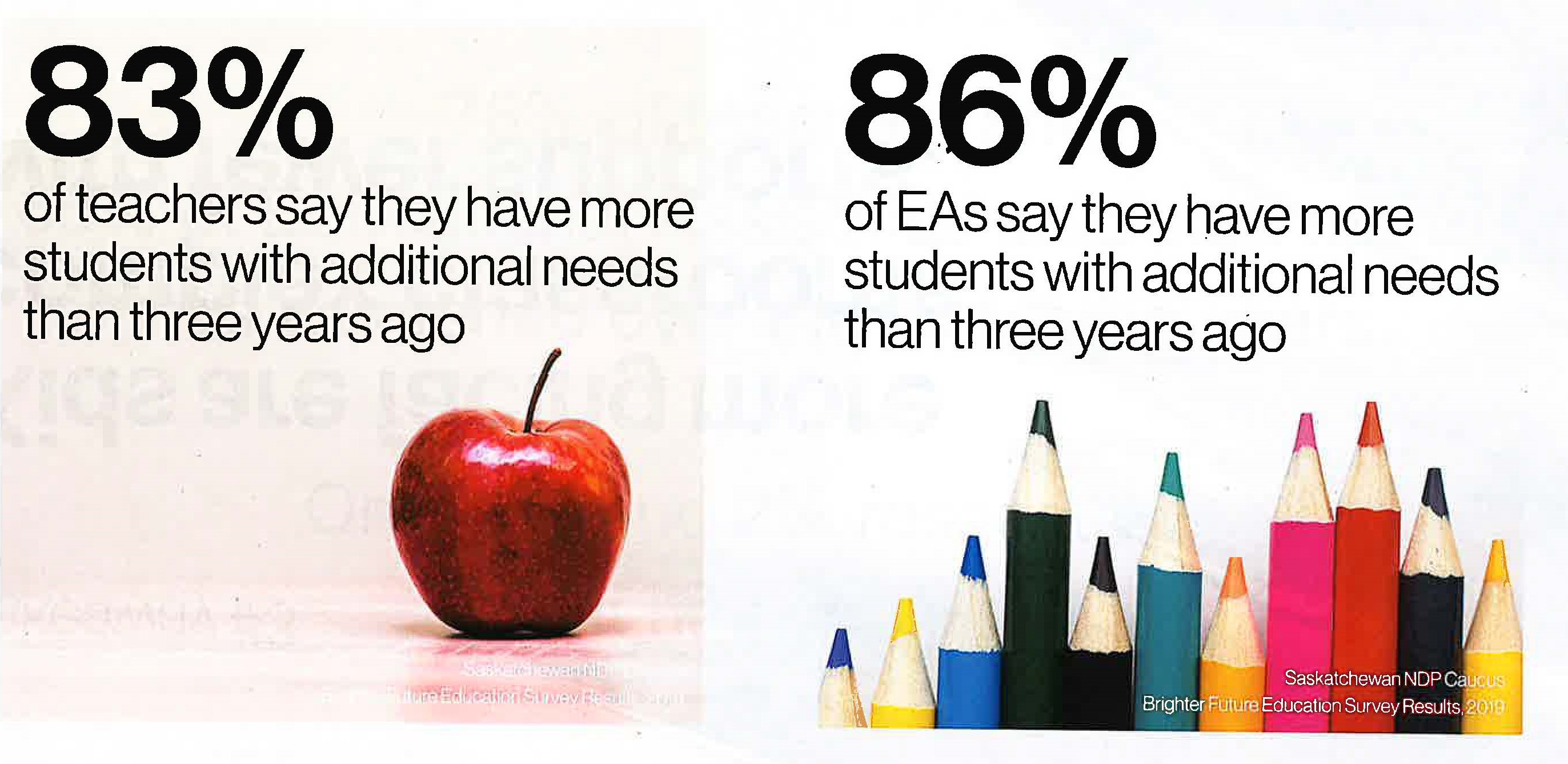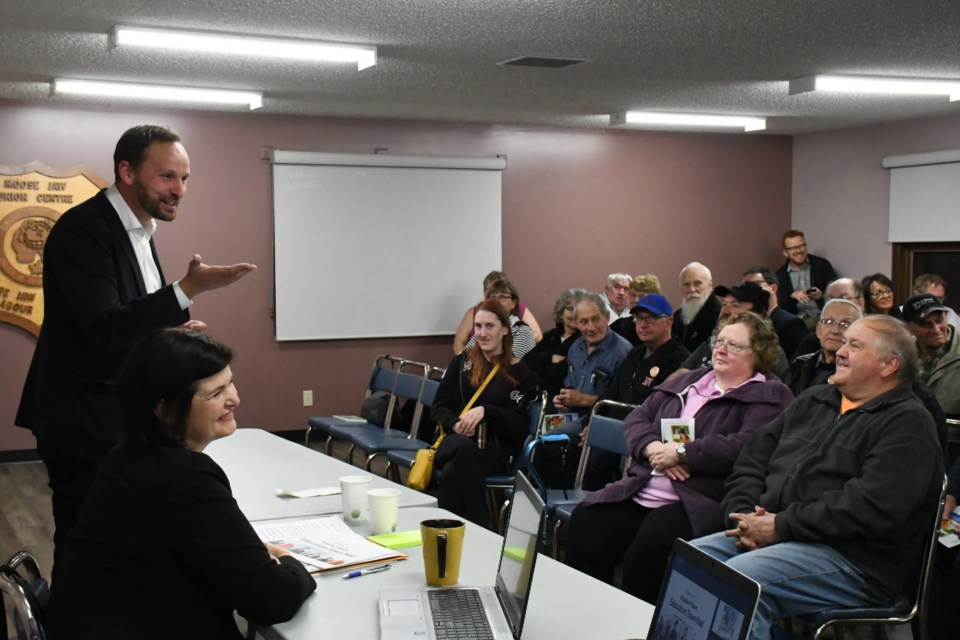Two in five teachers who responded to a recent survey say they have seriously considered leaving the profession due to burnout and a lack of classroom resources.
That was one of the statistics contained within the Brighter Future Education Survey that the Saskatchewan NDP conducted from May to August. More than 1,400 people responded and gave feedback on what they thought of Saskatchewan’s education system.
Of those who responded, 39 per cent were teachers, 28 per cent were members of the public, 21 per cent were parents, while the remaining 12 per cent were students, staff, and school administrators.
“With so many cuts it becomes harder and harder to do the job. This leads to feelings of helplessness, hopelessness, and feeling inadequate as a teacher. You put your heart into a job and can’t help students the way you’d like to,” one teacher wrote.
Saskatchewan NDP leader Ryan Meili and MLA Carla Beck, the party’s education critic, visited Moose Jaw on Oct. 17 as part of an education town hall. The party intends to visit communities across the province to share the results of its survey.
The NDP produced a small booklet containing the results from its survey. The 47 people who attended each received a copy.
Teacher burnout
“Not surprisingly, what we’re hearing anecdotally — but also through the survey — is that people are feeling burned out. They’re worried about how much they have to give,” said Beck.
Forty-one per cent of teachers said they rarely (36 per cent) or never (five per cent) have enough supports to help their students, the survey said. Meanwhile, 39 per cent of parents said their kids rarely (25 per cent) or never (14 per cent) receive the support they require.
Some teachers have retired earlier than they intended, Beck remarked. A friend of hers did that and took a job at the library since there was less stress there. She pointed out the last five to 10 years have been the most stressful on educators.
A changing landscape
Saskatchewan’s educational landscape has changed in the last five years, Beck said. Since 2014, more than 10,456 additional students have entered Saskatchewan schools, but per-student funding has decreased by $275. Meanwhile, the Sask. Party government promised 400 new educational assistants (EA) but has hired only 46 new people.
Morale also decreased when the minister of education suggested the average class size in Saskatchewan was 19 students. NDP research revealed there are more than 40 students in some classrooms.
There might be more students in schools, the survey said, but there are fewer counsellors (five per cent), fewer psychologists (nine per cent), fewer speech-language pathologists (eight per cent), fewer English-as-an-additional-language teachers (eight per cent), and fewer occupational therapists (18 per cent).
The provincial government receives $14 billion in revenue every year, said Beck. She thought the province shouldn’t scrimp on education funding.
“We are not talking about a pony in every classroom … ,” she added. “This is our kids’ future.”
Beck also thought all the resources of other ministries — particularly social services and health — should be focused to help students.
Learning conditions are worse
Survey results revealed 84 per cent of teachers, 77 per cent of EAs and 55 per cent of parents said learning conditions at their school have worsened during the last three years. Only three per cent, zero per cent and 12 per cent, respectively, said conditions have improved.
“This is an indictment of the (lack of) resources in the classrooms,” Beck said.
Staff morale is suffering
Survey results showed 78 per cent of teachers and 65 per cent of EAs said staff morale has worsened over the last three years. Only three per cent and two per cent, respectively, said it has improved.
Beck’s brother is a teacher in southeast Saskatchewan. He told her he is troubled about the education system. What hurts and scares him is his colleagues have said they would not recommend being a teacher to anyone.
“I can think of no nobler profession than education … ,” Beck said, “but morale in our schools is still suffering.”

Complex classrooms
Students are facing more complex classrooms with fewer supports, the survey said. Eight-three per cent of teachers believe they have more students with additional needs than three years ago. Meanwhile, 86 per cent of EAs said they have more students with additional needs during the same period.
“This is something we have heard right across the province, even in smaller centres,” said Beck.
Violent acts
Seventy-four per cent of educational assistants and 42 per cent of teachers reported experiencing or witnessing violent incidents more than once a week, the survey said. Meanwhile, 38 per cent of EAs report experiencing or witnessing violence every day.
If EAs are witnessing violence regularly, students are too, noted Beck. Violence happens because, despite educators’ best efforts, there are too many kids with too many needs in classrooms.
Classrooms are crowded
Eighty-two per cent of survey respondents said they would support a cap on class size, the data showed.
One solution to this problem is to increase education funding, Beck said. It’s also about choices and priorities. She pointed out the provincial government spent $2 billion on the Regina bypass over properly funding classrooms.
“We will continue to fight this and raise this issue and we won’t let the minister or government hide from it,” she added. “But we also want to be proposing solutions.”




